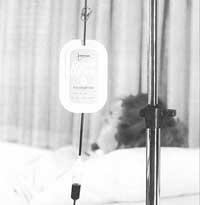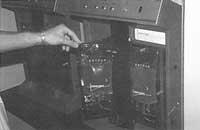Risks of blood transfusions
Blood transfusion in the absence of blood is a safe and effective measure, but it cannot be denied that it has its risks. The doctor should take into account all these risks when transfusion is strictly necessary. There are foreseeable risks, but not so with others. Let us briefly analyze the risks of transfusions.
Hemolytic reactions

It is due to a reaction between antigens and antibodies and, undoubtedly, the most serious is the one that appears when an inadequate or incompatible ABO blood group is transfused.
The main symptoms of this reaction are fever and chills, chest pain, dyspnea or respiratory distress, nausea, hypotension, bleeding, shock, etc. The reaction may appear immediately after the onset of the transfusion, but sometimes we can check it later.
Most of the serious hemolytic reactions that occur are due to errors in the identification of the patient or in the samples and pipes used in the laboratory (mixture of samples from two patients or similar). Hence the importance of faithfully following all the steps used for identification.
The treatment should be immediate stopping the transfusion, keeping the serum in the vein and calling the doctor responsible. If it affects the kidneys and has shock, plenty of fluids and diuretics will be given. New samples will be sent to the laboratory to check the blood group, check that the blood is well identified, and cross-test again.
Transmission of infectious diseases
In order for the blood of donors to have a low risk of transmission of these diseases, donors are selected under strict conditions and many studies are done to the donated blood before deciding their usefulness for transfusion. However, the risk does not completely disappear and the blood can be a transmitter of the infectious disease mentioned below.
Viral hepatitis
They can cause the following viruses: Hepatitis B and C virus, Cytomegalovirus and Epstein-Bar. Hepatitis can go unnoticed, it can cause chronic problems or even death. It is currently accepted that the possibility of transmission of hepatitis B is 1 per 50,000 transfused products and 1 per 3,300 transfused products in the case of hepatitis C.
Human retrovirus human

The best known are HIV-1 and HIV-2, which cause AIDS. Despite the controls performed, the risk of transmission is estimated at 1 for every 225,000 transfused blood products. If we take into account the AIDS data of Hego Euskal Herria, we can affirm that in the Autonomous Community of the Basque Country 4.2% of AIDS cases are due to the transfusion of products derived from blood or blood and in Navarre 1.9% of AIDS cases.
Another virus is the creator of an HTLV-I neuropathy, nerve disease. The risk of transmission of this virus is 1 per 50,000 products transfused in the Basque Country.
Citomegalovirus
It can cause serious problems in newborns, especially in preterm children. It can also cause disease in immunosuppressed. Most adults have been in contact with this virus and have developed opposite defenses, but by donating blood to the receptor that does not have those defenses we can transmit the virus.
Other infections Other infections
The transmission of malaria, shelter, bartholenosi, borreliosis, bruzelosis, toxoplasmosis, tripanosomiasis, etc. has been cited.
Bacterial contamination
It is very rare and occurs when bacteria, develop and transfuse them into the receptor appear in the bag carrying the blood product. If the blood product is temperate for too long, the risk increases.

In these cases there is a worrying fever, chills and hypotension, just start the transfusion. The measures to be taken are to immediately stop the transfusion and perform the pouch culture to identify the bacteria, put antibiotics quickly and take steps to overcome the shock.
Immunization of the receptor
Transfusion can give an immune response to some antigens present in red blood cells or hematins, leukocytes, and platelets. This response does not pose problems, but may condition possible subsequent transfusions.
Antibodies, called irregular antibodies, originated in the anti-hematite response, are detected in cross-tests. These tests are of obligatory compliance, since otherwise a serious hemolytic reaction can occur.
It is more difficult to detect antibodies against leukocytes. Receptors containing these antibodies may have fever and tremor with transfusions.
The problem that antiplatelet antibodies generate is that once the platelets have been transfused, no analysis is carried out.
Disease of the struggle between the graft and the host
This extremely rare complication can appear in children or adults with a diminished or undeveloped immune system. It is produced by lymphocytes in blood and has been shown to be more frequent to transfuse blood from a family member. The risk of this disease is significantly reduced by transfusing irradiated blood products to the aforementioned patients, thus inactivating lymphocytes.
Feverish reactions
This complication, which in most cases appears by antienlazative antibodies, can be 1% of the transfused patients. They appear in people sensitized by previous transfusions or pregnancies. As a treatment, transfusion is stopped and antipyretics are administered. If this reaction is repeated twice or more times, it is advisable to transfuse products with low leukocyte content.
Allergic reactions Allergic reactions
The clinical symptoms of this complication, which occurs in 1-2% of transfused patients, can be very different: pruritus, urticaria, angioedema and fever. We do not know very well why it appears, but in patients who have suffered more than one reaction it is convenient to administer antihistamines before transfusion.

Fortunately, anaphylactic shock is a rare complication. It is treated with adrenaline and corticoids. It affects patients without immunoglobulin A and forces to use clean hematine concentrates for transfusion.
Circulatory overload
In understandable terms, we can say that this is a situation in which the transfusion occurs too quickly or with a too high volume. Older people, low people, and patients who already have a high volume of blood or plasma are at higher risk for this complication.
The treatment should be quick and the subsequent transfusions will be placed carefully measuring the volumes well.
Iron overload
The accumulation of metals due to iron that carries blood is a complication that occurs in patients who receive transfusions for years.
Reduction of platelets and coagulation factors
When all body blood changes in less than 24 hours we talk about mass transfusion and in this situation it may be necessary to transfuse platelets and coagulation factors.
Metabolic complications
Metabolic complications in mass transfusions are due to several factors: patient shock, impossibility of accelerating transfusion, use of blood in the refrigerator, etc. The most notable complications are:
Hypothermia Hypothermia
Transforming large volumes of cold blood can form cardiac arrhythmias. To avoid this complication, which can increase the incidence of shock, we can use a heater that heats the blood at 37ºC.
Complications of citrate complications
As we mentioned in another work, in the blood bags a citrate is placed so that the blood does not cover. In mass transfusions this citrate can produce hypocalcemia, that is, a decrease in calcium. Patients who are not well exposed by the liver have a higher risk of suffering this complication.
Acidosis acidosis Acidosis
Although acidosis may appear at the first moment of mass transfusions, then alkalosis appears in the metabolization of citrate.
Changes in potassium
In the blood we carry stored in the refrigerator, potassium increases and by transfusing a lot of blood this potassium can cause hyperpotasemia.
General rules for transfusions Taking into account the following general rules, we can reduce some of the above-mentioned risks:
|





